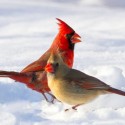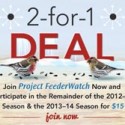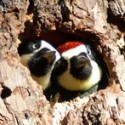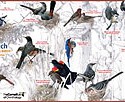 Photo ©
Keith Williams
Photo ©
Keith Williams

The Redder the Better
In many areas of the eastern United States, handsome Northern Cardinals are already singing to attract mates. A bird so visible in the winter landscape begs the question, “How does a flame-red bird that often nests close to the ground manage to be common in the eastern United States?” We are often asked how this conspicuous species has been so successful, despite its low rate of nesting success. Typically, less than 40% of nests fledge at least one young.
The answer may lie in their long breeding season. Cardinals do not migrate and often begin the nest-building process as early as late February. They can continue nesting into late August in some areas, which affords opportunities to nest multiple times. Another factor could be that cardinals are habitat generalists. They can nest in open woodlands, dry shrubby areas, or even the suburbs. Their nests are placed in live trees, shrubs, or vine tangles, anywhere from 1–15′ high. A recent study in Texas* revealed that cardinal nest sites were not particularly different from random sites, suggesting that they may not be limited by suitable nesting locations. However, there seem to be benefits from nesting higher up and later in the breeding season, both of which probably thwart some potential predators. Cardinals also tend to nest in the denser parts of trees or shrubs, which may provide some vegetation cover.
But how is it adaptive for the males to be such colorful and obvious songsters? The flamboyant males sing from high perches and do not trade their breeding plumes for a drab winter coat. According to research compiled in The Birds of North America Online, brighter males have higher reproductive success and better territories, and plumage brightness is positively associated with parental care. The intensity of the cardinal’s red coloring is related to its diet, and bright coloration is a signal to females that the male probably holds a good territory (although this is not necessarily true for urban areas). The females, through a process called sexual selection, have selected for this bright coloring in the males. And because the female’s colors are muted, they provide her with a protective camouflage that the male lacks. This also aids in nest concealment when she is incubating. Furthermore, juvenile and adult cardinals tend to have high survival rates, possibly because they don’t endure the stress of migration.
Against all odds, the Northern Cardinal is marvelously adapted to its environs. So the question is not “Why are they so successful?” but rather, “Why wouldn’t they be?” If you are lucky enough to find a cardinal nest this year, won’t you help us learn more about this fascinating species by monitoring it with NestWatch?
*Sperry, J. H., D. G. Barron, and P. J. Weatherhead. 2012. Snake behavior and seasonal variation in nest survival of northern cardinals Cardinalis cardinalis. Journal of Avian Biology, 43: 496–502.

A Special Offer for You
We hope you’ve been enjoying the birds visiting your feeders this winter. Winter finches and other irruptive species, like the Red-breasted Nuthatch, are making news this winter. Many finch species typically spend most of their time farther north in Canada. How big is this movement of birds? Getting reports from citizen bird watchers like you is the only way to find the answer.
Special February Offer!
New participants joining Project FeederWatch in February will automatically be signed up for next season, too. Join now for the rest of the 2012-13 season, and you will receive the 2013-14 season at no extra charge!
Join today! For $15, you’ll receive:
- Project FeederWatcher’s Handbook and Instructions;
- an identification poster of the most common feeder birds; and,
- Winter Bird Highlights, an annual summary of FeederWatch findings.
The fee helps offset the costs of staff support, scientific analysis of data, and your FeederWatch kit.

Website Update
We’re thrilled to announce that project-wide data downloads are now available online. You can once again explore NestWatch data for the United States and Canada. Participants can export data summaries in three easy steps:
- Go to http://nestwatch.org/nw/public/export.
- Select the species, year, and location of interest.
- Select the type of data you’d like to download: species summaries, reproductive success calculations, or raw nesting attempt data. You can either accept the default variables or customize your own list of variables.
That’s it! You’re ready to export the data, which comes packaged as an Excel spreadsheet. Please note: these data are intended to be used for casual exploration by the curious citizen scientist. If you are interested in using NestWatch data as part of a formal research project, please contact us by emailing nestwatch@cornell.edu and including “NestWatch Data Sharing Program” in the subject line.

You’re Invited to the Great Backyard Bird Count
Please consider taking part in the 16th annual Great Backyard Bird Count (GBBC) February 15-18. The count is being integrated with the eBird online checklist system—which means that the count will be global for the first time. Anyone, anywhere, with Internet access can take part in the count. Because you already participate in NestWatch, you will not need to create a new account for the GBBC. If you’re watching birds that weekend, simply enter your checklists at www.birdcount.org. You’ll be prompted to enter your existing login information.
Participating is easy. Simply watch birds for at least 15 minutes at the location(s) of your choice on one or more of the count days. Estimate the number of birds you see for each species you can identify. You’ll select your location on a map, answer a few questions, enter your tallies, and then submit your data to share your sightings with others around the world.
Please consider participating in this free, fun, late-winter bird count!

Monthly Winner
At the beginning of each month, NestWatch randomly selects one participant who has entered data that month to receive a copy of the NestWatch Common Nesting Birds of North America poster. This month’s lucky winner is Jay Little. Congratulations, Jay!